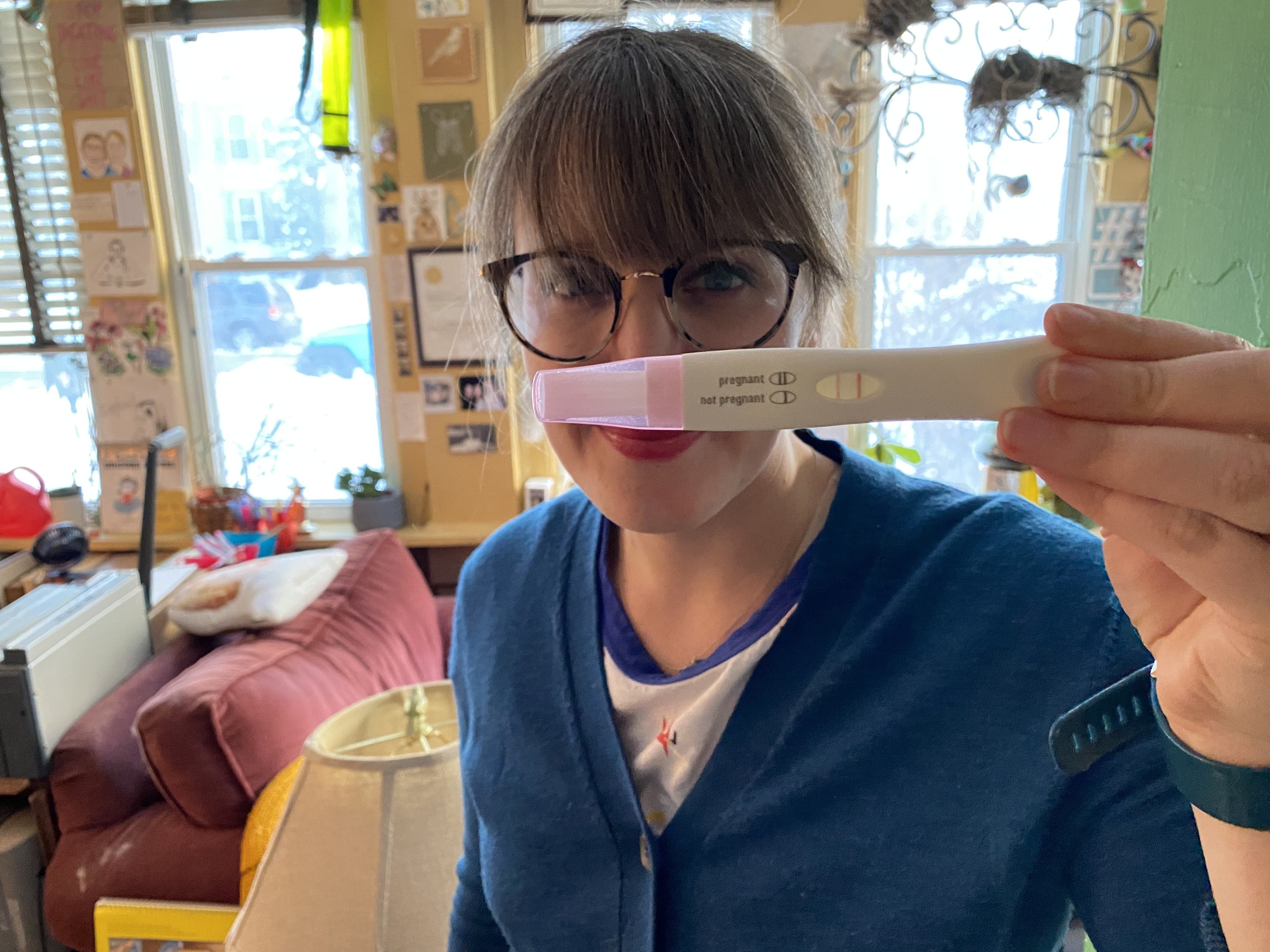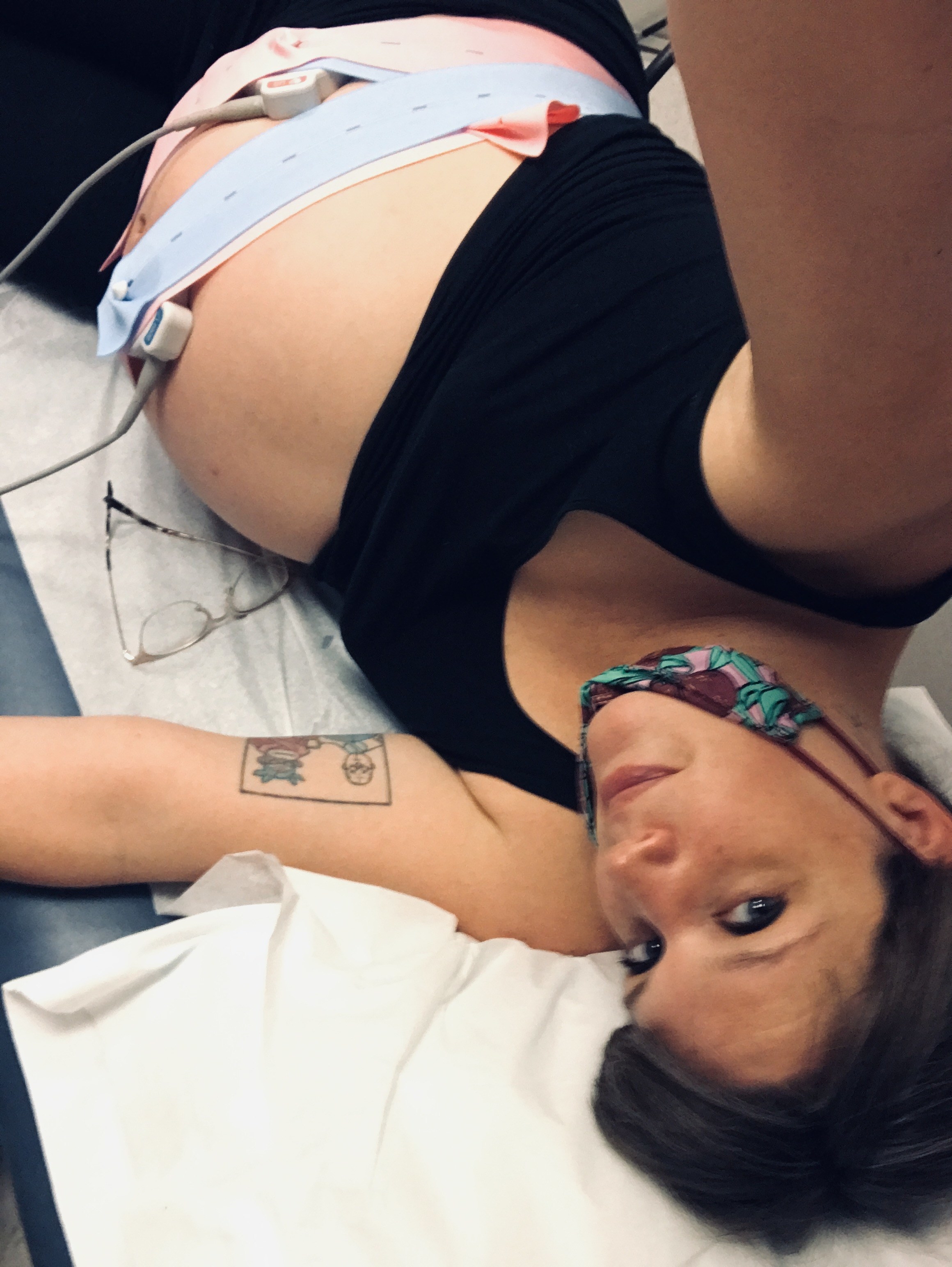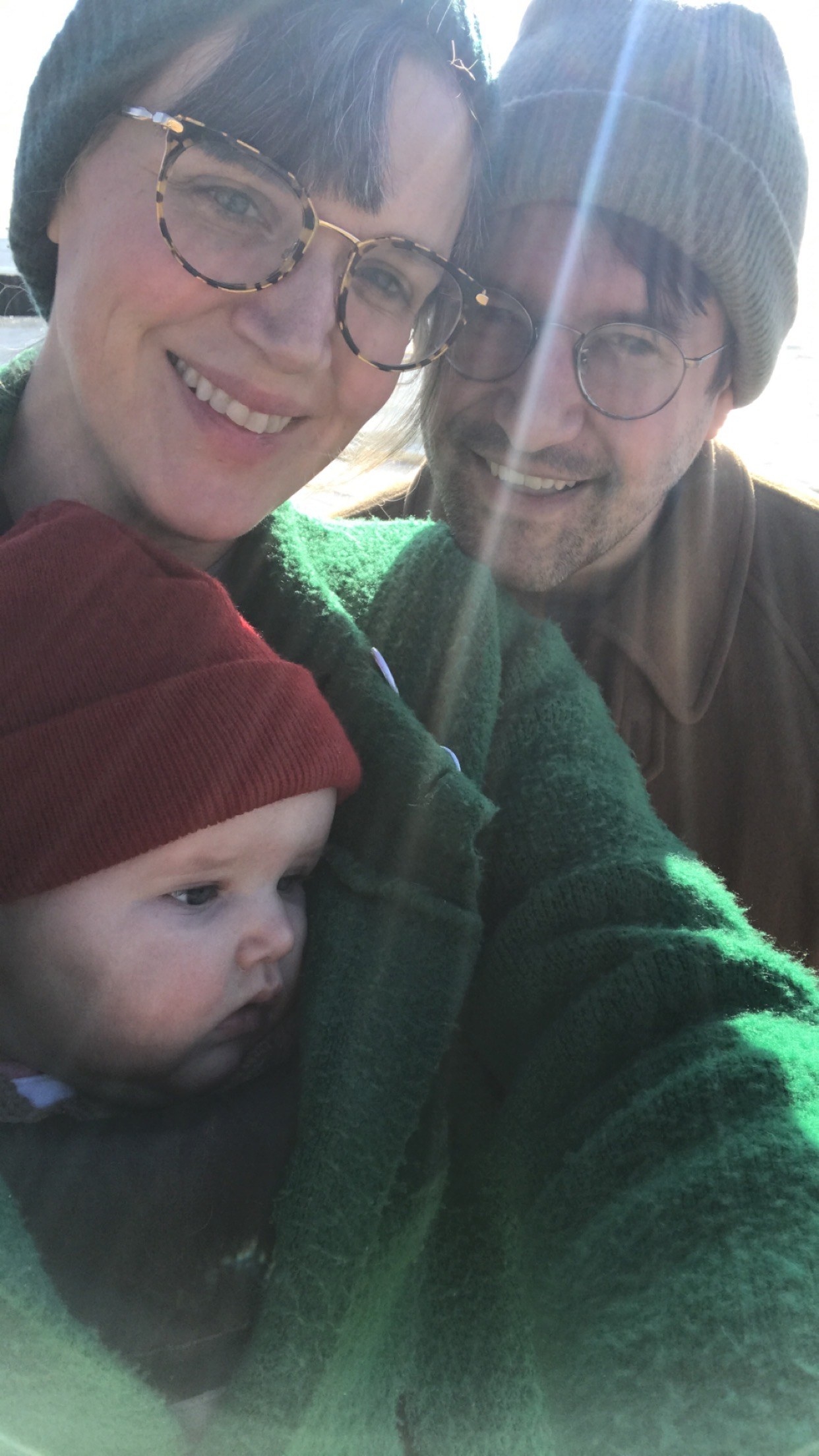
When two lines appeared on my pregnancy test after months of trying and failing, I knew whom to tell first. It had been his sperm, and we shared a bed, a mortgage, and marriage certificate.
It was harder to know whom to tell second.
Should I tell my girlfriend of four years, who lived in my neighborhood, and knew how much this would mean to me? Or my boyfriend of six years, who lived across the country now, but with whom I had shared every intimacy? Should it be my roommate and close friend, who was also pregnant? Or my sister, who had known me longest and loved me deepest of anyone close to my age? I ended up choosing someone else entirely: my friend Ari, who had found out she was pregnant just days earlier. I felt that she would know what I was feeling, in real time. But this was only the first seemingly impossible road that lay ahead of me as a pregnant person who was also polyamorous.
The first thing I did after Luke and I decided we wanted to try to get pregnant was talk to my other partners about how they felt about this potential change in our relationship dynamic. (TL;DR: They were both psyched.) But we hit a roadblock: For a long time, conception didn’t seem like it was on the table. We tried to get pregnant for almost a year, but the familiar heartbreak of getting my period every month had started to become too much for me. I’d just decided that I needed to stop actively trying when we finally conceived. Our entire polycule was so incredibly happy for us. From the onset, I felt supported.

There is a brief honeymoon period in most pregnancies, when the excitement outweighs the nausea, and you get to enjoy a few blissful days imagining flower-speckled onesies and fantasizing about nursery wall colors. And then, typically, the first trimester disrupts everything you once took for granted (sleeping soundly, wanting to eat, not crying constantly), spinning your body into a hurricane of symptoms. For me, the honeymoon lasted exactly four days, and then there was seemingly nothing but vomiting and being unable to walk to my car without getting winded.
My first trimester symptoms were textbook — nausea, exhaustion, emotional meltdowns, headaches, swelling — but there were other experiences that I had no idea how to address, because they had to do with my very unique relationship structure. I met my now-husband Luke in New Orleans in 2014. I had already been experimenting with open relationships, and Luke became one of three people I was dating at the time. I met my boyfriend, Bob, in 2015, and then Luke and I moved to Chicago, where I would be attending graduate school. My other New Orleans relationships waned with the move, but Bob and I stayed close and decided to make our relationship work long distance. I met my girlfriend, Kat, at a wintry party in 2017 and immediately had a crush, which quickly developed into something more. These three have collectively filled my dance card ever since.
Loving relationships between “friend” and “romantic partner” are also a critical part of building community and chosen family for me, so there are other people I want to name when I am asked, “Who are your partners?” It’s hard to explain to people what Bethany is to me — our relationship isn’t romantic, but she’s more than a friend. I met her when we both worked at a public high school; she and her husband, Brett, both moved in with me and Luke in 2019. Bethany and I talked from the beginning of our cohabitation about how we both wanted to start trying to get pregnant. We discussed the perks of sharing a home while having babies, and they were ample: round-the-clock babysitters; people to bounce ideas off when you weren’t sure whether to move from milk to solids; a bounty of Pack-and-Plays and high chairs and toy buckets. And so it wasn’t an accident that I got pregnant while she was pregnant, and that for a full year, our house oozed with pregnancy hormones.

Sex has always been an important part of my life, but when I got pregnant, my sexual appetite changed seemingly instantly. I still wanted to have sex, but I felt some weird, new distance toward my male partners. I pretty much only wanted it with Kat, who also had a high tolerance for me crying in her bed for literal hours about minutiae, such as seeing an injured beetle or not being invited to a fondue party. Since my body was so swollen, I noticed myself feeling more defensive about how it was perceived by the men in my life: It was so much bigger, and I was socialized to believe that bigger is unsexy to men. Even though Luke and Bob were totally supportive, I grew private about being naked around them.
At the same time, I started to feel jealous for the first time in years. When I became pregnant, the long lockdowns were ending and people were just starting to hang out again. Luke wanted to go on a date with a woman he hadn’t seen since before the pandemic began, and I noticed that my whole body reacted to that idea with tension and anger. Intellectually, I knew this reaction was irrational. Here I was, slinking away every week to have sex with my beautiful girlfriend, and I couldn’t let him even go on a date with this woman? What was wrong with me?

This felt particularly frustrating because I’d worked on calming myself when the feelings of jealousy came up. It had been such a long time since I’d felt this way about Luke dating other women and, honestly, I had never felt it so acutely. I lay in bed sobbing, feeling like my hormones had been hijacked.
There is very little literature on what it is like to be polyamorous and pregnant. Polyamory and Pregnancy, a 2013 book by Jess Mahler (then Jessica Burde) is a helpful how-to featuring anecdotal examples from folks who have been in my position. But while it covers how to deal with unexpected pregnancies, delivery options, and how having a baby impacts a relationship, it didn’t answer my questions about how to deal with the extreme mood swings and reinvigorated jealousy. The book notes that many pregnant people, including the author, “experienced increased paranoia, jealousy, territoriality, and obsessiveness.” Ultimately, though, they write, “There is no good advice I can give to bio mothers on this one,” adding that others in the polycule shouldn’t take irrational-seeming personality changes personally.
As Mahler acknowledges, knowing that your emotions are irrational doesn’t make them any easier. On top of feeling frustrated, jealous, and bloated, I also felt incredibly alone. I do not exaggerate when I say I cried three times a day every single day for nine whole months.
Luckily, my therapist seemed unsurprised when I told her I was battling some unwelcome emotions. She said, “It sounds like you’re nesting.” I’d heard of pregnant people nesting but assumed it meant buying every sale item at Crate and Barrel and redecorating in a surge of energy incongruous with every other exhausted state of pregnancy. I’m sure that does happen to many pregnant people, but my concerns had more to do with the people around me than soft furnishings. Slowly, though, it started to make more sense. I realized the idea of a nest was just as much about the safety and security of the relationships that hold it together as it was four walls and a roof.
I later discovered that limiting social engagements is one of the main observed signs of the well-documented nesting instinct in pregnant people. Several studies have found that nesting is a behavior that evolved to protect unborn babies from outside threats, and humans aren’t the only animals who do it: dogs, pigs, and (perhaps obviously) birds also make physical and social changes to their environments when they’re awaiting a birth.
In an interview, Mahler told me that they actually experienced very similar nesting impulses toward the ends of their pregnancies. “I didn't want strangers in the home while I was getting ready for baby,” they said. “I didn't want new people in my life. I wanted to gather all my people around to be sure everything was ready.”
My body was turning itself inside out to prepare for a new person who would soon live in the nest. I needed my partners to take care of me, because my body was taking care of a baby. There just wasn’t space in my life for anything else.
It made sense, then, that my sexual desires had changed. My girlfriend and I have a lot of cuddly, kissy, nonpenetrative sex, and it felt safe, and necessarily centered on female pleasure. My male partners are extremely attentive lovers, but penetration didn’t feel as safe, even if I intellectually comprehended that it was.

Here is where my story gets a happy ending, which is not necessarily guaranteed for polyamorous people stepping into the complex and intense journey of becoming parents.
Dr. Elisabeth Sheff, who has studied the long-term effects of polyamory on family planning and child-raising, said that pregnancy can go a lot of different ways in a polyamorous configuration. When the pregnancy is unplanned and constitutes a deal-breaker for one or more people in a multi-person relationship, things can get understandably painful pretty quickly. But, she said, “When an entire group is excited about a pregnancy, the pregnant person gets a lot of time and affection and attention and relaxation. There’s support for that person.” That was the case for me.
I leaned on the most valuable asset in any relationship, particularly when you have multiple partners: ample, exhaustive, loving conversation. It helped that all my partners also have therapists of their own, which meant they could take their frustrations and complaints to a third party before bringing the edited, pared-down versions to me. After Luke came back from therapy following one of my crying fits concerning his potential hot date, he told me, “It makes sense that you feel jealous. I really don’t need to go on a date. What’s most important is that you’re feeling comfortable right now.” I don’t know what Luke said in therapy, or what his therapist said, but I felt like a weight had been lifted.
And from that headspace, it was easier to make concessions. After Luke validated my feelings of jealousy, I felt a lot better about him spending time with another woman. She, on the other hand, didn’t love having Luke’s pregnant wife dictate the terms of her relationship with him (which, fair), and they never went out again. This is a somewhat typical back-and-forth for a polyamorous relationship, and I feel lucky that Luke was so OK with how things ended up. He was willing and able to focus his attention and energy on our imminent addition.
These conversations about sex, belonging, jealousy, and boundaries ended up being really important. If you think communication matters when you’re talking about multiple adults making out and touching parts, wait until you add a baby to the mix. There are countless decisions, values, and principles to discuss, and the more adults in the picture, the more complicated the picture becomes. Sheff advises that polyamorous people expecting children make a clear plan about what the future will look like. For example, what will the relationships between the partners, the adults, and the children be, outside of the romantic relationships among the parents? If a partner puts resources into raising the child but doesn’t have a biological or legal relationship with that child, what rights will that person have? Who will do the child’s laundry? Take them to doctor’s appointments? Wash their hair? And what legal steps need to be taken to protect everyone involved?

After the basics are laid out, Sheff urges polyamorous parents-to-be to actively seek out or anticipate potential disagreements. “How does everyone feel about circumcision? Spanking? Homeschooling? Religion? Introducing grandparents? Vaccinations? Bring all this up and see where there might be conflict,” she said. She added that when children become involved in polyamorous configurations, it’s critical to have a plan for what might happen if the relationship changes and folks split up. “Do it while you’re happy enough to talk to each other. Create an exit plan and hopefully you'll never have to use it,” she said.
Many pregnancy books recommend you have a birth plan that outlines how you’d like things to go in a perfect universe so that you have quick answers to likely questions before you have smoke coming out of your ears (and a human coming out of your vagina). Sheff’s questions remind me of some of the ones I saw on sample birth plans — only, rather than planning for the birth, these questions help to prepare a polyamorous nest.
What I love most about being polyamorous is all the interesting conversations it makes way for, and all the radical honesty it can facilitate. It’s not always comfortable, and it’s never categorically easy, but in the best cases, it can create a relationship structure in which all people involved talk to each other, ask questions, make compromises, share how they’re feeling, and honor how others are feeling. As far as structures go, I’d say that’s a pretty solid one.
Understanding that my nest was more about the people who built it than wallpaper or succulents freed me. My second and third trimesters weren’t any less emotional, but the emotions made more sense, and explaining my experience to my partners made me feel less lonely. Our daughter was born into a community of people who had just spent nine months doing a whole lot of communicating, and her life is infinitely better for it. Her room is tiny and full of hand-me-down furniture — I have still never entered a Crate and Barrel. But her nest is as strong and carefully constructed as can be. ●
